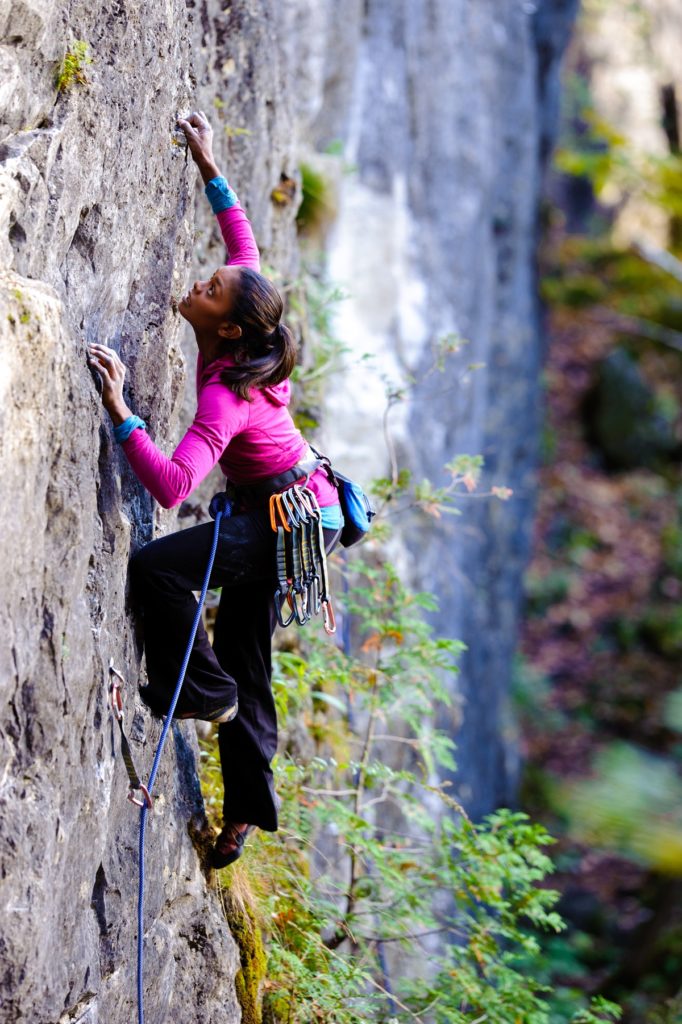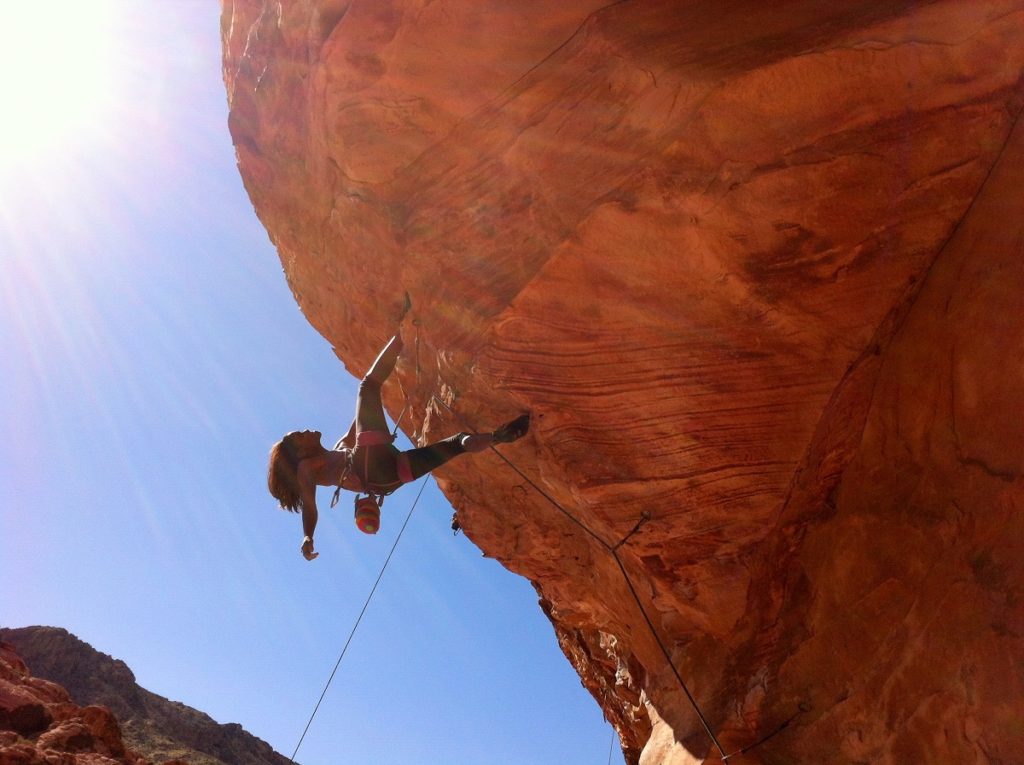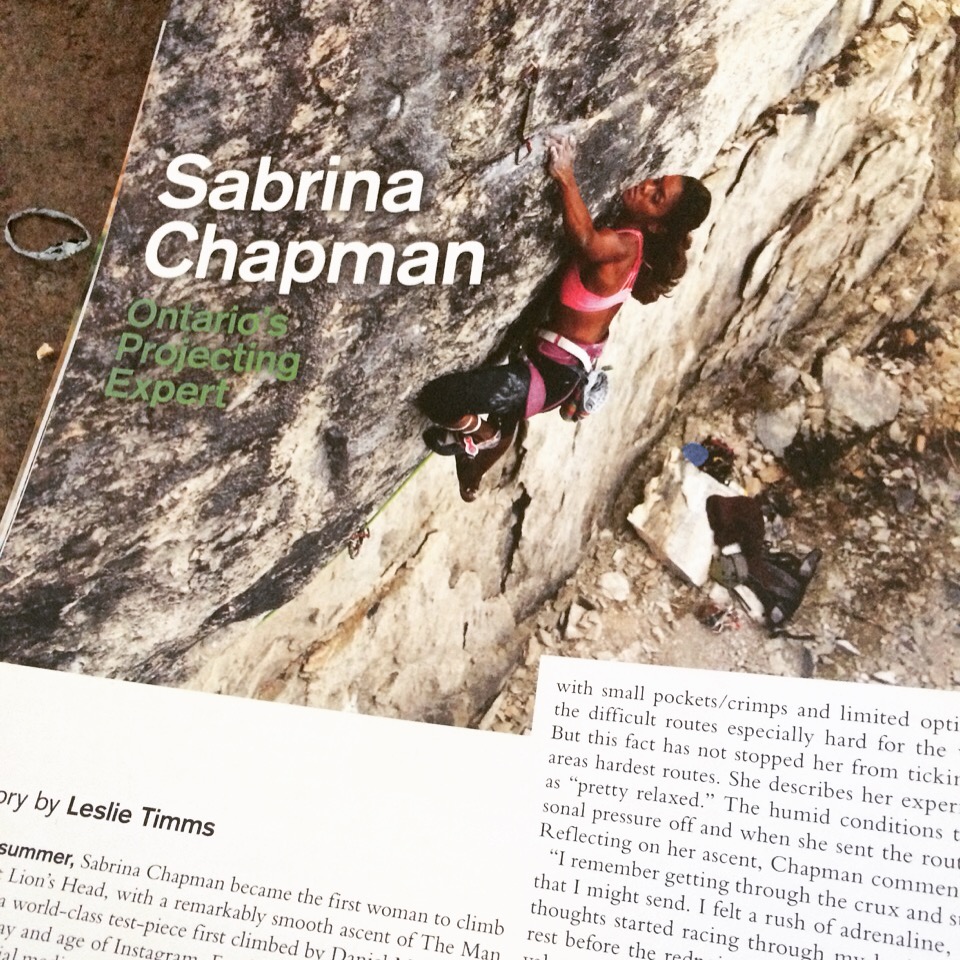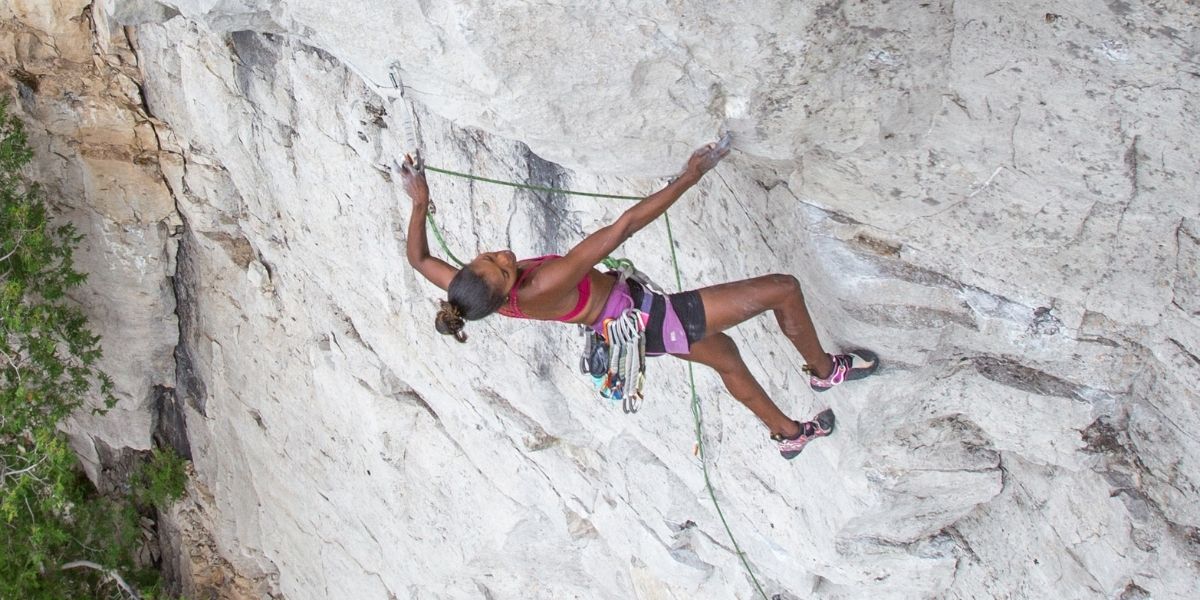Sabrina Chapman is arguably one of the most impressive, and least talked about climbers to crush in the last decade. If you don’t know this Toronto-based climber’s name, don’t worry, you aren’t alone. It’s likely a product of the lack of media inclusion and visibility of BIPOC (Black, Indigenous, People of Color) in the climbing community.
You see, Sabrina isn’t just an all-around lady crusher, she’s one of the few Black women in the world to enter the world of the climbing elite. While she just turned 40 this year, that’s the least important “4” in her life right now. Far more important is her goal to enter the elite level of climbing by sending 5.14a.

Her long-standing project, Titan, is a monstrously long 5.14a sport route located at Lion Head in Ontario’s Bruce Peninsula National Park. Originally FA’ed by Ontario’s legendary Daniel Martian and sent by only a handful of climbers since, Titan is a true test of a climber’s all-around abilities, beginning with 50 feet of exhausting overhand and sharp limestone crimps and ending with over 60 feet of technical slab and face climbing.
Watch Titan Project: A Kickstarter funded film on Sabrina’s 5.14a project
For Sabrina, the challenge is welcome, just one in a series she’s tackled head-on throughout her life. From a difficult childhood to racism and finger injuries to cancer in her tricep, the amount of challenges Sabrina has overcome with grace and humility is downright astounding.
As if all that wasn’t impressive enough, she didn’t even start rock climbing until she was 26 years old! Many of us have been climbing since we were children and don’t have half the sends that she does!
Despite how amazing she looks, Sabrina is a truly humble person who shies away from the spotlight, and would never brag about herself like I’m inclined to. It was truly an honor to speak with her, and you’ll find endless kindness, genuineness, and unflinching honesty in all her words, even as we dive into some tougher topics.
If you haven’t had enough of Sabrina by the end of the interview, we can’t recommend enough for you to check out the recently released short film, Titan Project, created about her by the outdoor diversity organization Melanin Base Camp.
You didn’t start climbing until you were 26 and now you’re crushing 5.13 and pushing the 5.14 barrier. How did you make such amazing progress with such delayed entry into the sport?
“The gym I started climbing at really laid the foundation for how I would approach route climbing and why I enjoy it so much. The style of setting there was very similar to the style of outdoor climbing that we have in Ontario: small crimps, vertical faces, and poor feet. So I think I lucked out in that 1) That was the style of climbing there, and 2) That it was the style of climbing I really enjoyed. Plus, I got so obsessed with it from the jump, and because I’m not very career focused and I don’t have kids, I was able to put all my time and effort into getting better at climbing.”
What inspired you to start climbing in the first place?
“I had tried climbing once in college on a whim with a friend of mine and I liked it, but I didn’t try it again until I was 26 after I had gotten married. It was actually my now husband who was a college friend. Once we got married, he started to pick it up again with one of his friends and he would talk about it and it just sounded awesome. Finally, I was just like, ‘I want to try it, too. Let me try.’ And that was it.”
What does your training look like? Do you follow specific programs? Do you self train or have professional assistance?
“I’ll start with some advice for people who are trying to make big gains or get into 5.12 climbing, the thing that made a huge difference for me. Initially, I really hated the idea of focused training, anything that wasn’t actually climbing, like hanging on a hangboard. So I switched from route climbing to bouldering and in the off-season I would just boulder. That made a huge difference in my route climbing. Especially if you’re more of a vert or technical climber and you struggle with being explosive, it’s a great way to train without more focused training.
I did that for one winter and then we had a spring trip to the Red River Gorge in Kentucky. I was flashing and onsighting mid 12s all over the place and that was my first moment of, ‘Oh my gosh, if I just focus a little more I can get really strong.’ So I started reading as much as I could about hangboarding and finger training. When I started training there were no apps or people offering so much online training advice like we have today. We had this PDF put together by a Canadian climbing coach that we passed around it and that was it.
I know I could probably improve faster if I got a coach, I never have. I’m completely self-taught, but I read a ton and listen to podcasts. In addition to now enjoying training, I enjoy learning about training, experimenting on myself, and learning about the adaptations that happen when I do X, Y, and Z.”
What about nutrition? Do you follow a specific eating regimen or experiment with different diets?
“I’ve been vegetarian for 25 years. Not that it automatically makes me healthy; it’s just always been my diet. Overall, I’m pretty aware of what I put in my body and how it makes me feel. But I go through phases like anyone. In the winter, I don’t really care about what I’m eating as long as I’m not eating so badly that I feel gross.
But certainly, once the outdoor season comes around, I buckle down. I want to feel as good as I can and use my energy systems as well as they can be used so I pay a lot of attention to what I put in my body and stick with real whole foods.”
Do you stick mostly around Ontario to climb or do you travel much? What are some of your favorite places you’ve been to climb?
“We usually travel in the spring and fall, before and after the Ontario seasons starts and ends. I don’t even know for how many years we’ve been going to the Red [River Gorge]. It’s so different from our style of climbing and it’s so fun and beautiful. I would say that’s our favorite favorite favorite spot to go!
I’ve traveled twice for bouldering but the only time I’ve flown anywhere was to Bishop and it’s such a spiritual place. I felt so connected to the land when I was there and just constantly stunned. Bishop definitely stands out as the dreamiest place I’ve ever been. Sometimes I think it’s a good thing I started climbing as an established adult because if I was younger and I went to Bishop, there would be no turning back. That would be my life.
Going to these places as an adult, it’s so easy to see why people are so moved to just get in their van and travel around.”

Sabrina Chapman getting to know the sandstone of Red Rocks, Nevada.
Tell me about your project, Titan.
“The first 50’ [Titan is a massive 120’ long] are really hard, maybe 13c/d climbing. It’s on a slight overhang, with really long movements on sharp limestone crimps. Then there’s a move to get onto the headwall that’s kind of the stopper move for me. I have to reach back to a left hand crimp with low feet then cross under my arm and down for another crimp. Then Gaston out left and bump again left, and all that feels so hard when I’m taxed. But that’s THE move. If I stick that move, that’s it. I’m going to the chains.”
While there is another redpoint crux at the top that brings the route its 5.14a status, Sabrina isn’t too worried about it. While there is a chance she might fall there, she’s done the climb clean from the fall at the lip.
“Last year I wasn’t able to get on Titan. I hurt my finger in the spring and it didn’t get better in time for the season. I got on it a couple times but I was super scared to try hard. I wasn’t in the point of healing that my head knew my finger was okay. So I got on it for the first time last weekend actually, and I’m hoping some magic will happen before the weather turns, but we’ll see.”
Sabrina explained to me that the Lions Head, which is located north of Toronto right on a body of water, gets really cold really fast, “like a hammer drop”. That means Sabrina likely has until mid-October to send or else wait until next summer.
“The good thing is that I have all my beta, I have everything written down, and I’ve been on it so much that I’m not worried about beta anymore. I’m just trying to get the fitness back up and put some good redpoints in.”
Why Titan? What got you so psyched on that climb in particular?
“I got the first female ascent of the 5.13d next to it and while I was on it, I was always glancing over at it like, “Ugg, look at that thing!”
It was also my husband’s first 14a. It took him two years so I belayed him on it a lot. Like a lot a lot. Just the way he talked about the moves, I was like, ‘Oh my gosh it sounds amazing’. But also, I’ve only ever seen guys on it and it certainly suits tall, lanky guys. The moves are long and if you’re tall, you’re not as extended, you have much better feet, and there are a few spots where you have a much better rest. And I thought, ‘I want to be the girl that does it.’”
Sabrina, by the way, is only 5’4” but with a +4” ape index, she carries all her length in her arms and legs. If she achieves her goal, hers will be the First Female Ascent of the climb. “
Something that I’ve noticed, sometimes if you’re really really strong, you don’t always find the most efficient way to do things, but if you’re used to pulling on small holds to get you through small moves, your mind is a little more open to possibilities than just the very obvious holds that are in your face. So I was very curious to see if I could come up with a different beta than what everyone else was using. Which I can but it also makes it much harder for me. My life would be a lot easier if I could just walk away, but I really can’t.”
How did the idea for the short film Titan Project come about?
“Danielle from Melanian Base Camp and Aman from Beast Fingers Climbing got in touch with me and pitched this idea. I guess they had heard that I climb 13+ and was projecting 14a and wanted to know if I would be interested in doing a film. At first I said no. I was super uncomfortable with the idea. I’m not a spotlight-type person and I like to fly under the radar and do my own thing.
But at the same time, I was starting to think about representation in our sport and in outdoor material in general. It was something I’ve been yearning to see since I started climbing. Only recently had I really been feeling the lack of it, so everything was kind of crashing into place.
Related Post: Watch Titan Project: Sabrina Chapman’s pursuit of 5.14a
After weighing the discomfort I felt being in the spotlight (which I find still slightly horrifying) with the appreciation that this could contribute in some small way to the beginning of something (or at least adding to something to a movement that’s underway), I said yes. I think what’s most shocking to me about it is how many people were so enthusiastic about it. It’s not something I’ve ever talked about with people in my climbing circle and to feel validated with ‘No, other people want this, too, it’s not just you Sabrina’ was really important to me.”

Before did you ever notice any negativity or “otherness” from the climbing community? Tell me about your experience in being a Black woman climber, especially one of the very few pushing hard grades.
“For the majority of my climbing career up until the last six months, I have put aside how different I felt from everyone else. I’ve put aside the fact that I’m the only Black girl at the crag. There are fundamental life experiences that all Black and Brown women have shared; there is a basic way we move through the world and a language that we speak that I don’t have when I go to the crag. For the longest time, I was aware it was there but I stuffed it away because I’m there to climb. I want to focus on climbing and not talk about race. Because if I talk about race, I have to acknowledge how I’m feeling and I don’t have time for that.
Once the protests started in the U.S. after George Floyd was murdered, I started having some white people in my community reach out to me wanting to talk to me about what my experience has been like. It was almost like a slap in the face. Not only have you never acknowledged in any fundamental way that I am a Black person, you’ve never asked me anything to do with it before and now suddenly you want to talk about racism. I was infuriated and I had no idea this was sitting inside me until people started treating me like NOW I’m the Black girl.
But before I wasn’t. Before we’re never gonna talk about that and actually commit a whole bunch of microaggressions and pretend that we don’t know what we’re doing and now we’re going to have a one on one discussion about what my experience has been like. I couldn’t handle it and I snapped at people, I responded harshly and it’s something I’m still working through.
Now things have been opened. The dam has broken, the scales have peeled back, there is no going back for me now in talking about what it’s like for me. And if it makes you uncomfortable, you’re not community. If you don’t want to listen, you’re not my community.”
What are some of those microaggressions? What are some common things you find in the climbing community?
“There’s this thing I’ve had happen to me over and over again in the gym with white women. Say there’s me and two other white women and all three of us are strangers. If the two white women are working this problem, you can see that they’re kind of competitive with each other, but if I walk up and start trying it, they’ve now aligned themselves to be in competition with me. I notice they suddenly start cheering for each other when I come up. White women in the climbing community have consistently been part of my worst experiences.”
She then went on to tell me about one of the most blatant examples of racism she has experienced as a climber.
“The first time I went to Chattanooga, TN on a bouldering trip. We drove 15 hours one way there and when we arrived late, we got out of the car to grab some dinner. A car rolled up in the intersection, rolled down its window, and the guy told me to go back to where I came from. Then the passenger screamed the same thing. Because the white people I was with never understood how deeply racism affects people, they told me, ‘It’s okay. Don’t worry about it. Forget it,’ and no one wanted to talk about it. Everyone wanted to talk about what problems they were going to get on the next day, and I was just like, ‘Where does all that stuff go?’
I had to put all that stuff somewhere in my body and try to climb hard the next day with my friends. I don’t think there’s a good grasp in the climbing community how difficult that is and the kind of toll it takes on you. And if you spend so much of your life putting it away and suddenly everyone wants to tear it open and poke at it and look at it, it’s a lot.
Now I’m more open about speaking about my experiences because the majority of people in my community are white and if they consider themselves to be good people, they need to learn about these things that people in their community are experiencing if they want to support them. Put aside the defensiveness, open your mind for five minutes that someone is experiencing a different life than you and there are systemic reasons why they are experiencing life differently from you.”
What are some ways you see the climbing community as being able to step up? To get better? At the same time, what do you think is the biggest hurdle to being a more diverse and inclusive climbing community?
“These are huge questions and I’m just one person. The only thing I can think of is for everyone to read and do the workbook for Me and White Supremacy [by Layla F. Saad]. Everybody. Stick with it, however long it takes and however hard it is. White supremacy and white colonialism is at the fundamental core of every aspect of systemic racism in North America.
For outdoor companies and climbing magazines, get some Black and Brown people in your boardrooms. Get them in hiring positions. Don’t ask me to do an article and think, ‘Well, here’s our commitment to diversity.’ It has to be the people who are making fundamental decisions. If your boardroom is monochromatic, if all the people on your staff are white, if white people are consistently outnumbering BIPOC, there’s a problem. You can’t fundamentally change the system without disrupting the entire system and tearing it down. You can’t keep doing the same thing and expect a different result.
You can say the same thing for training. I didn’t want to train; all I wanted to do was climb routes. I didn’t want to boulder; I hated bouldering. But at some point I had to say, ‘Stop complaining, take off your harness, go boulder, and do some pull ups. See what happens.’”
Are there any outreach and diversity organizations you want to give a shoutout to? Those doing great work in the realm of promoting climbing diversity right now you want to encourage folks to look into?
“Absolutely! There are Climbers of Color, Brown Girls Climb, and Melanin Base Camp. Not related to climbing but still in the outdoors and in the Toronto area would be Brown Girl Outdoor World, and on the east coast of Canada, Colour the Trails.”
A question we close all our climber interviews with, what’s one piece of gear you can’t live without?
“My harness!” I could hear how much she loved it with how emphatically she answered my question. “I always get Petzl. I climb on the Selena and I love it. It’s a fundamental piece for keeping me safe and I really appreciate it.”
Explore More
Related articles and pages you'll love- Gifts for Rock Climbers
- Sabrina Chapman’s Titan Project
- Training for Rock Climbing
- Moja Gear’s Weekly Gear Picks
- How to Build Your First Trad Rack
- Best Shoes for Bouldering, Sport, and Trad Climbing








